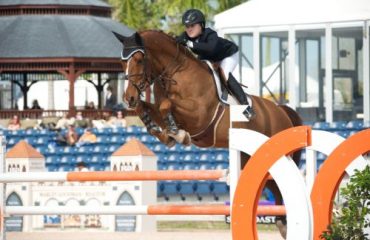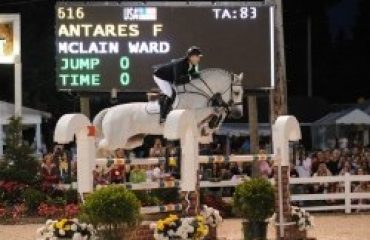
Boyd Martin riding Gloria Callen’s mare Welcome Shadow
Photo by Amber Heintzberger
Well known for both his fun-loving approach to life and his indefatigable work ethic, Boyd Martin has represented the U.S.A. in three-day eventing at two Olympic Games and two World Championships, and was on the gold-medal-winning Pan Am Games team in 2015. Boyd’s wife, Silva Martin, is a grand prix dressage rider and they have a son, Nox. Boyd and Silva train out of their own farm, Windurra USA in Cochranville, Pennsylvania, and spend winters at Stable View Farm in Aiken, South Carolina.
How do you teach a person who is new to eventing how to gauge their horse’s pace on cross-country?
After years and years of riding cross-country, I believe I’ve got a subconscious metronome for what the speeds are at each level. I’d have to say for novice and training, a nice, comfortable working canter is ideal. There’s no pressure in hurrying any of the technical fences and you can let the horse stretch out a little in the galloping lanes, but you shouldn’t feel like you’re pushing any limits to make the optimum time.
Once you get to preliminary and above, time becomes a much bigger factor. I don’t necessarily go for the optimum time every time I go cross-country; you must get a feel and understanding for your horse’s condition, the footing, the temperature and other factors, and not become obsessed with winning a prize at that event at the expense of your horse.
To practice, find a big field or a track and measure the distance out — you can use a meter wheel — to determine what 350, 400 and 500 meters looks like. Practice cantering that distance in one minute to figure out what, for example, 400 meters per minute feels like. But understand that speed varies on-course due to hilly terrain, turns on-course, and galloping type fences vs. turning questions. The ultimate goal is to make the optimum time without looking like you’re riding fast. I’d encourage anyone to go to an event and watch the top riders on-course. Notice how smooth and gentle they look, particularly as they go from a galloping speed to a balanced canter.
Don’t get too obsessed with this. Over time and with experience, you’ll develop a feel for the correct pace. As for your position on cross-country, when I teach clinics, I often suggest that riders pick a rider that they want to emulate. With YouTube and so on, you can watch some of the best in the world online. Notice their position and style over fences but also how they ride between fences: how short their irons are, how their body is positioned and how they use their body to balance the horse as they gallop over the terrain. This visual aid gives you something you can try to copy at home.
How do you work through problems like refusals or run-outs?
First things first, we want to try never to put our horse in a situation where it wants to run out. Cross-country is all about confidence, so you need to start small and simple and over time increase the size and difficulty to jumps as the horse becomes more competent. There are different degrees of pressure you can put on the horse when he’s questioning the fence. I try to anticipate whether the horse might be hesitant and one or two strides before that moment, I use my leg stronger and maybe a bit of stick to give him confidence on that last stride.
Basically, when horses come to training, I’d be proud to say that most of them have never had a stop or run-out. Often, if a horse is running out, it’s an indication that somewhere in its training there’s been a mistake made. Often it’s with ditches, banks or water and the rider may have to go back to a lower level to give the horse confidence. My rule is to spend a year at each level, maybe a year and a half at intermediate, so that the horse is confident and never over-faced.
How’s it going with the new U.S. Eventing coach, Erik Duvander?
Erik is definitely a different style coach than we’re used to. He’s very into the horse’s suppleness and flexibility and so far that’s been our main focus: not asking for too much difficulty but getting the horse relaxed, soft and supple. Then the exercise you’re working on is quite easy. We’re only a few weeks into the year but he spends a week or 10 days here in Aiken, South Carolina, and then heads down to Ocala, Florida, before he comes back to Aiken, so we’re getting plenty of time with him. I’ve known Erik for a long time and watched him train the New Zealand team particularly over the past couple years, and his training style works very well with me. He’s very personable; he’s not trying to put on a big show if anyone’s watching and he’s always willing to get on the horses if he thinks that will be helpful. I think it’s going to be very good for the U.S. team, having him in our corner.
What are your thoughts on what to wear for eventing?
Silva and I are both so proud and honored to be associated with Ariat. Obviously, this is a brand that’s recognized all over the world for outdoor fashion and equestrian apparel. When it comes to riding gear, they are really world class. If you look at the majority of international event riders, they are wearing Ariat breeches, boots, gloves and jackets. I’ve been absolutely blown away by the clothing line that has come my way. The gear is very high quality in its production as well as comfortable and fashionable to wear around the house and barn and in any outdoor activity. Ariat is an always-evolving company. They are the perfect blend of stylish and fashionable, durable clothing that has the latest technology in breathable fabrics that move with you when you are riding and active. Believe me, when you are riding around a big four-star cross-country course, you need equipment that can be put to the test.













